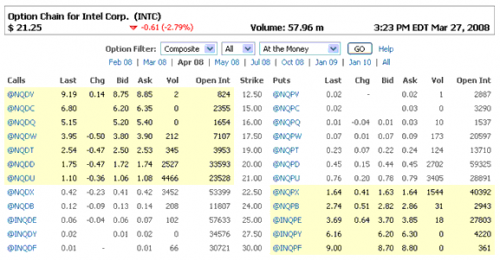|


DATE: Wednesday May 27th 2015 11:00 am
Where: www.DayTradingRadio.com
Participants: Joel (Trade4pay) Brian (Bfiguy) Jerry (jerryjr) Michael (michaelD) Mark (Oobie) Anthony (Anthony) and More..
The Basics
This is a basic intro to Options and below are some notes to help understand and prepare for our guest speakers. This will be open discussion focused on outline you see below. These will be recorded and posted in the Members Forum, This will be also Part 1 of a continuing series. Some of the terms will be very basic. But we will have great speakers who activily trade options and have a great deal of knowledge and tips to share.
Outline of Discussion:
What Terms you will Learn:
Calls
Puts
Strike Price
Exercise
Assignment
Expiration
In the Money (ITM)
At the Money (ATM)
Out of the Money (OTM)
Intrinsic Value
Time Value
Volatility
1. What is an Option?
An option is a standardized contract providing for the right - but not the obligation - to buy or sell an underlying financial instrument. In our context, this underlying is a stock or exchange traded fund (ETF). The contract controls 100 shares, and is good until a defined expiration date. The price at which shares can be bought or sold also is defined by the contract, and is known as the strike price.
There are two types of options: calls and puts. You can buy or sell either type. If you buy an option you are the holder of the contract and considered to be "long," while if you sell an option you are the "writer" of the contract and considered to be "short."
The buyer of a call has the right to buy the underlying security (e.g. 100 shares of Google) at the strike price on or before the expiration date. The seller of a call has the obligation to sell the shares, if asked.
The buyer of a put has the right to sell the underlying security (e.g. 100 shares of Google) at the strike price on or before the expiration date. The seller of a put has the obligation to buy the shares, if asked.
2. What is Premium.
In exchange for the right to buy ("call") or sell ("put") an underlying security on or before the expiration date, the purchaser of an option pays a premium. The price of the contract is known as the debit, and it is the purchaser's maximum risk. On the other side of the trade, the seller of the option receives the premium as a credit to his/her brokerage account, but is obligated to buy (in the case of a short put) or sell (in the instance of a short call) the underlying shares if the purchaser exercises the contract. Brokerages hold cash from the premium as a guarantee against short positions.
The strike price, or exercise price, of an option determines whether that contract is in the money, at the money, or out of the money. If the strike price of a call option is less than the current market price of the underlying security, the call is said to be in the money because the holder of the call has the right to buy the stock at a price which is less than the price he would have to pay to buy the stock in the market. Likewise, if a put option has a strike price that is greater than the current market price of the underlying security, it is also said to be in the money because the holder of this put has the right to sell the stock at a price which is greater than the price he would receive in the market. The converse of in the money is, not surprisingly, out of the money. If the strike price equals the current market price, the option is said to be at the money.

3. What is Intrinsic Value and Time Value.
The premium of an option has two components, intrinsic value and time value.
Intrinsic value describes the amount the stock price is above the strike price (for calls), or below the strike price (for puts). Therefore the amount by which an option is in the money is intrinsic value. It is also the value of the contract at expiration.
Time value is defined as the option premium minus the intrinsic value. It is the amount that you pay for the possibility that it will be worth more in the future. Therefore an at-the money or out-of-the-money option has no intrinsic value and only time value.
4. Buying Calls.
You want leverage? Buying calls gives you leverage over 100 shares of an underlying stock (or ETF) at the strike price until the expiration date. Long calls are used to profit from upward moves in the underlying.
Again using Google for an example, the GOOG December 500 call option gives you the right to buy 100 shares of GOOG for $500 per share up until the expiration date in December. You would do this with the expectation that the price of the option will rise, usually through the rise in the price of the underlying stock.
5. Exiting Long Calls
When a call has been purchased, the position can be closed in one of three ways:
- Selling the call - Once an option is bought it can be sold at any time. This is the most common way of exiting a long position, and the only way of exiting a long call that captures any remaining time value in the option.
- Letting it expire - If a call gets all the way to expiration, it will expire worthless if it is out-of the money (when the strike price is above the stock price). If the stock price is above the strike price by $.01 or more, it will be automatically exercised and shares will be delivered to your brokerage account. Long calls are almost always sold before expiring, since at that point they will have lost all time value.
- Exercising your call - Utilizing the "right to buy" that is inherent in the call contract is known as "exercising" the option. This results in your brokerage delivering shares of the stock to you at the strike price. Options are rarely bought with the intention of exercising the underlying right. Taking this course also forgoes any remaining time value in the option.
5. Buying Puts
Want to profit from the downside? Puts give the buyer the right to sell a specific number of shares (usually 100) of an underlying stock at the strike price until the expiration date. Long puts will profit if the underlying price falls, all else held equal. Buying puts therefore offers a limited-risk way to profit from the downside. This also makes them a way to protect positions as insurance
Exiting Long Puts
When a put has been purchased, the position can be closed in one of three ways:
- Selling the put - Once a put is bought it can be sold at any time, and this is the most common way of exiting a long position. This is the only way of exiting a long position that captures any remaining time value in the option.
- Letting it expire - If a put gets all the way to expiration, it will expire, worthless if it is out of the money (when the stock price is above the strike price - See Options Pricing). If the stock price is below the strike price by $.01 or more, it will be automatically exercised and shares will be "taken" from your brokerage account. Long options are almost always sold before expiring, as at that point they will have lost all time value.
- Exercising the option - Utilizing the "right to sell" that is inherent in the put contract is known as exercising the option. This delivers shares of the stock from your account at the strike price. Options are rarely bought with the intention of exercising the underlying right. Taking this course also forgoes any remaining time value in the option.
6. What is an Option Chain and How ro read one.
For any given option contract, we need to know the most recent prices and other factors. Option chains show data for a given underlying's different strike prices and expiration months.

· At the top, we have the stock information and then different expiration months. In this case we are looking at Intel (INTC) April 08. ( I know it's 08 but i put this together fast I clipped some old examples)
- Down the middle are the strike prices. Calls are on the left, puts on the right.
- Contracts in the money are yellow, and out of the money are white.
Each strike lists:
- The price of the last trade ("Last")
- The price at which there are willing buyers (the "Bid")
- The price at which a contract is offered for sale (the "Ask" or "Offer")
- The volume of the day's trading ("Vol")
- The contract's "open interest" ("Open Int"), which tells us how many active contracts there are for a given month and strike.
High open interest figures, generally near the at-the-money strikes, tell us there are more prospective trading partners who could accept your price. But note that volume does not equal open interest, since some trades are made to close positions.
Options Roundtable will begin Wednesday 11:00am and should wrap up around 2:00pm or later
| 
